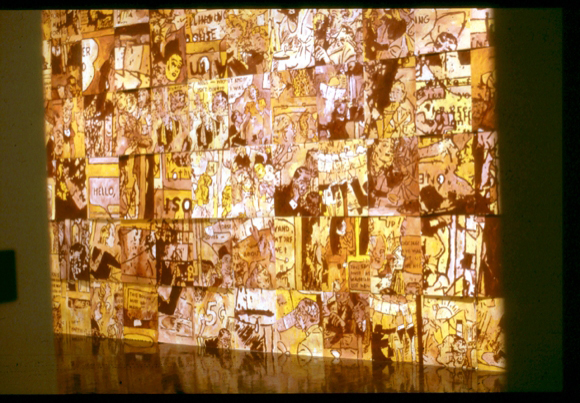NOTE: Ultimately, the correct response to each of these prompts is one or more paintings.
1. How is a painting different from the screen of your phone?
2 Does the image in a painting end at the edge of the canvas, or continue to infinity?
3. What is a painting? Give five examples.
4. What isn’t a painting? Give five examples.
5. Are graffiti, vintage advertising gouache illustrations, Judy Chicago’s Purple Atmosphere animation cels, Rauschenberg’s White Painting and circus sideshow banners painting?
6. Is house painting painting? How do you know when you’re finished painting a house?
7. When did you first get the idea that you didn’t know how to paint?
8. Is it cheating to use a projector? A ruler? To copy someone else’s work? To pay someone to make your painting for you? To use pigments you didn’t grind yourself, canvas you didn’t weave, boar bristles you didn’t harvest?
9. If you were in prison, in solitary, with no art supplies, and you had an idea for a painting, what would you do?

Doug Harvey, Clear the Grid, 1993, Oil on canvas, 78 X 60 in
10. Which end of the brush is the correct end to hold? What amount of paint is the correct amount to load on your brush? What is the correct viscosity of the paint? What are the correct shapes to paint? What are the correct colors? What is the correct content?
11. How long does it take to learn how to paint, and then begin painting?
12. Have you looked at my work on my website? Which is your favorite piece? Which is your second favorite piece? Which is your third favorite piece?
13. If, as Bob Ross suggests, painting is an autonomous parallel world in which you are free to do absolutely anything, and—as many others have asserted—the goal of modern art is to erase the boundary between art and life, does that mean it’s okay to kill people that annoy you, as long as it looks good?
14. Why would someone crawl through hundreds of yards of cold dark tunnels dragging art supplies and torches in order to paint animals and abstract patterns on rock walls? How much would a painting like that be worth at auction?

Doug Harvey, Men Weeping While Sniffing Flowers – Tigris of Gaul, 2013, acrylic on canvas, 60 X 48 in
15. Is it okay to paint with your eyes closed? Are you the author of the resulting painting?
16. What is the difference between drawing and painting? Can you make a painting without drawing?
17. Look at your painting. Look at the thing you’re painting. Do they look the same? If not, fix it.
18. Do people see colors differently? Do some see color better? Is this a genetic variation?
19. What the hell’s the matter with you, can’t you see what’s right in front of your face?!
20. What is the evolutionary survival value of painting, as an activity, and as an artifact?
21. What is the least number of colors that can be used in making a painting? The least number of marks? The smallest surface? The fewest ideas?

Doug Harvey, Stay Gold Pony Boy, 1998, mixed media on canvas 84 X 62 in
22. What is the most number of colors that can be used in making a painting? The most number of marks? The largest surface? The most ideas?
23. Can a good painting make you feel bad? Can a bad painting make you feel good?
24. Is it possible to spend your entire life on a painting and never finish it? Is it possible to spend absolutely no time on a painting and finish it?

Doug Harvey, Joe’s Temper #31, 1994, oil on paper, modular wall painting, dimensions variable, each unit 24 X 18 in
25. If a painter in a Chinese sweatshop makes a perfect copy of a Corot landscape for $50, is it a real painting? If a forger makes a new work in the
style of Kandinsky and sells it to a museum? If a computer generates a variation on Van Gogh and does a 3D printed surface that’s indistinguishable to the naked eye? What if two artistshave exactly the same idea on opposite sides of the planet, and one of them finishes five minutes before the other?
26. Why bother making a painting when you can just take a photograph?
27. Why would anyone pay half a billion dollars for a fake-ass Leonardo when they could get a perfect Chinese sweatshop copy for 50 bucks?
28. How close can you stay to your painting surface for the duration of its execution? How far away? What tools can you use to extend these parameters?
29. How many ways and how many times can you change your physical relation-ship to a painting over the course of its execution?
30. If someone buys your painting and you later realize it wasn’t finished, are you entitled to continue working on it? If the collector or museum
resists, is it appropriate to break and enter? What if the collector or museum director annoys you?
In addition to being a noted second-tier noise musician and international bon vivant, Doug Harvey has taught studio painting classes in Los Angeles for several decades. This in an excerpt from the full length 1001 Prompts for Beginning Painters, forthcoming from Artillery Books.


